一:背景
1. 講故事
上個月有位朋友加wx告知他的程式有掛死現象,詢問如何進一步分析,截圖如下:
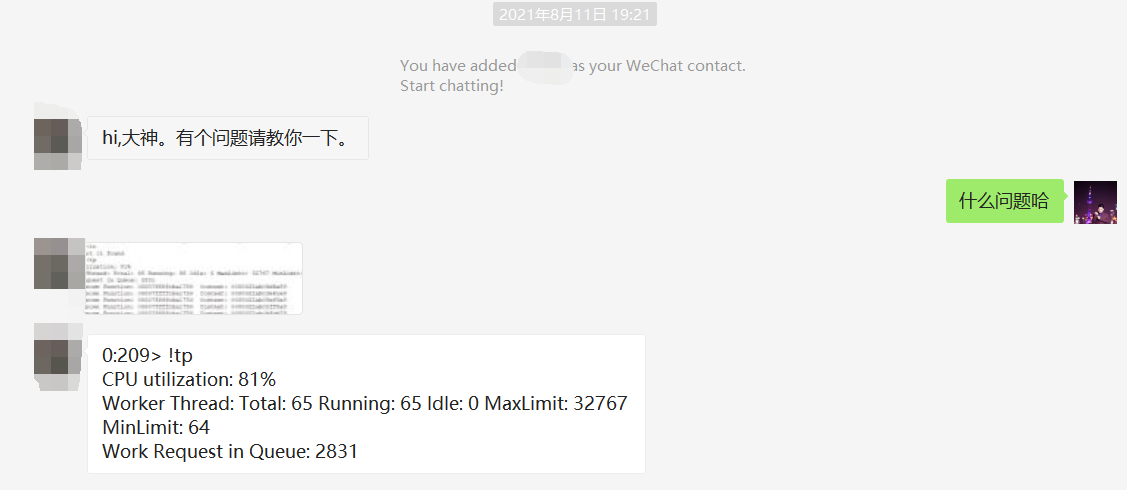
看這位朋友還是有一定的分析基礎,可能玩的少,缺乏一定的分析經驗,當我簡單分析之後,我發現這個dump挺有意思的, CPU,記憶體,掛死 三樣全佔,程式悲慘莫過於此。。。
既然找到我,我得想辦法化解他的痛苦,由易到難我們逐一分析這三樣都是因為什麼原因所致?
二:三高分析
1. 掛死原因
根據 40+ 的dump分析經驗,掛死大多是由於某種情況導致執行緒卡死,導致後續請求堆積在 threadpool 中,要想驗證,可以使用 !tp 命令檢視執行緒池佇列。
0:000> !tp
CPU utilization: 81%
Worker Thread: Total: 65 Running: 65 Idle: 0 MaxLimit: 32767 MinLimit: 64
Work Request in Queue: 2831
Unknown Function: 00007ffffcba1750 Context: 0000022ab04d4a58
Unknown Function: 00007ffffcba1750 Context: 0000022ab03e4ce8
...
Unknown Function: 00007ffffcba1750 Context: 0000022ab825ec88
Unknown Function: 00007ffffcba1750 Context: 0000022ab825a458
Unknown Function: 00007ffffcba1750 Context: 0000022ab8266500
Unknown Function: 00007ffffcba1750 Context: 0000022ab8268198
Unknown Function: 00007ffffcba1750 Context: 0000022ab826cb00
Unknown Function: 00007ffffcba1750 Context: 0000022ab8281578
--------------------------------------
Number of Timers: 0
--------------------------------------
Completion Port Thread:Total: 2 Free: 2 MaxFree: 128 CurrentLimit: 2 MaxLimit: 32767 MinLimit: 64
可以很明顯的看到執行緒池佇列有 2831 個任務堆積,這就導致新進來的請求無法得到處理,所以就出現了掛死現象,接下來就來看看這些執行緒都幹嘛去了,為啥效率那麼低,可以用 ~*e !clrstack 調出所有執行緒棧,截圖如下:
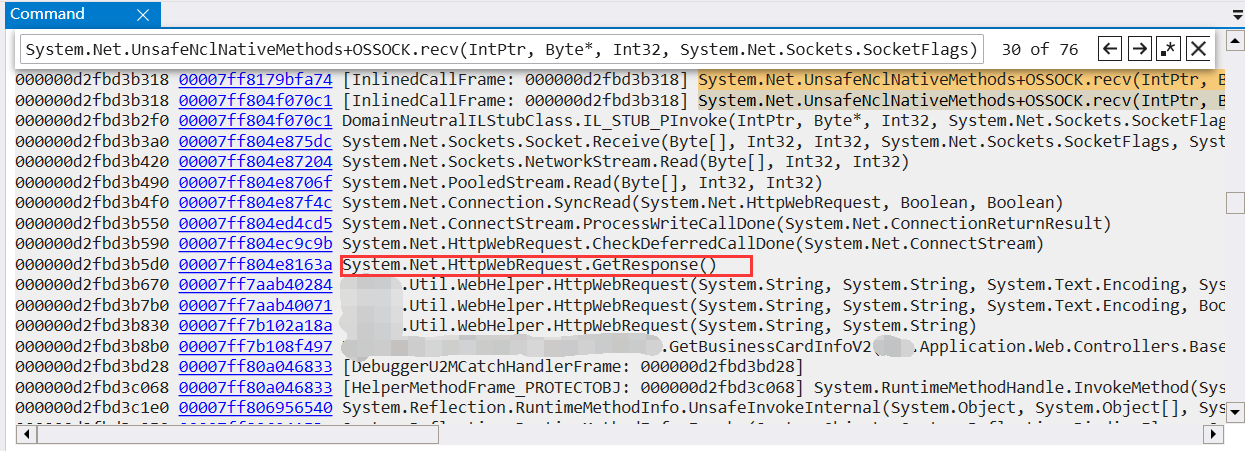
掃了一遍後,發現有很多的 System.Net.HttpWebRequest.GetResponse() 方法,有經驗的朋友應該知道,這又是一個經典的同步http請求過慢導致的程式處理不及的掛死,有些朋友可能好奇,能不能把網址給我扒出來,可以是可以,用 !dso 命令即可。
000000D2FBD3B840 0000023269e85698 System.Text.UTF8Encoding
000000D2FBD3B850 00000236e9dd2cb8 System.String application/x-www-form-urlencoded
000000D2FBD3B870 0000023269e85698 System.Text.UTF8Encoding
000000D2FBD3B9A8 00000231aa221a38 System.String uSyncAppxxx
000000D2FBD3B9B8 00000231aa201a70 System.String VToken={0}&Vorigin={1}&QueryJson={2}
000000D2FBD3B9C0 00000231aa202200 System.String http://xxx.xxx.com/API/xxx/BusinessCardFolder/Connector/xxx/GetPageList
我去,這url還是一個外網地址,了,本身同步方式就慢,這地址更是雪上加霜哈。。。難怪不卡死
2. cpu爆高分析
從上面的 !tp 輸出中也看出來了,當前 cpu = 81% ,那為什麼會這麼高呢?根據經驗大概就是 lock鎖,GC觸發,死迴圈等情況,可以用排除法。
- 是 lock 鎖嗎?
可以用命令 !syncblk 看一下同步塊表。
0:000> !syncblk
Index SyncBlock MonitorHeld Recursion Owning Thread Info SyncBlock Owner
212 0000023ef3cdd028 3 1 0000023ef40efa40 8d70 209 000002396ad93788 System.Object
-----------------------------
Total 297
CCW 3
RCW 4
ComClassFactory 0
Free 139
從輸出看,lock 鎖沒什麼問題,接下來用 !mlocks 命令檢視下其他型別的鎖,看看有沒有什麼新發現。
0:000> !mlocks
Examining SyncBlocks...
Scanning for ReaderWriterLock(Slim) instances...
Scanning for holders of ReaderWriterLock locks...
Scanning for holders of ReaderWriterLockSlim locks...
Examining CriticalSections...
ClrThread DbgThread OsThread LockType Lock LockLevel
------------------------------------------------------------------------------
...
0x49 209 0x8d70 thinlock 000002396ad9ba90 (recursion:0)
0x49 209 0x8d70 thinlock 000002396ad9baa8 (recursion:0)
0x49 209 0x8d70 thinlock 000002396ad9bac0 (recursion:0)
0x49 209 0x8d70 thinlock 000002396ad9bad8 (recursion:0)
0x49 209 0x8d70 thinlock 000002396ad9baf0 (recursion:0)
0x49 209 0x8d70 thinlock 000002396ad9bb08 (recursion:0)
0x49 209 0x8d70 thinlock 000002396ad9bb20 (recursion:0)
0x49 209 0x8d70 thinlock 000002396ad9bb38 (recursion:0)
0x49 209 0x8d70 thinlock 000002396ad9bb50 (recursion:0)
0x49 209 0x8d70 thinlock 000002396ad9bb68 (recursion:0)
0x49 209 0x8d70 thinlock 000002396ad9bb80 (recursion:0)
0xe 152 0x8e68 thinlock 0000023669f7e428 (recursion:0)
0x41 208 0x8fb4 thinlock 00000235e9f6e8d0 (recursion:0)
0x17 161 0x9044 thinlock 00000238ea94db68 (recursion:0)
0x16 159 0x911c thinlock 000002392a03ed40 (recursion:0)
0x47 206 0x9264 thinlock 000002322af08e28 (recursion:0)
我去,發現有大量的 thinlock,而且 DbgThread=209 執行緒居然有 1000 +,截圖如下:
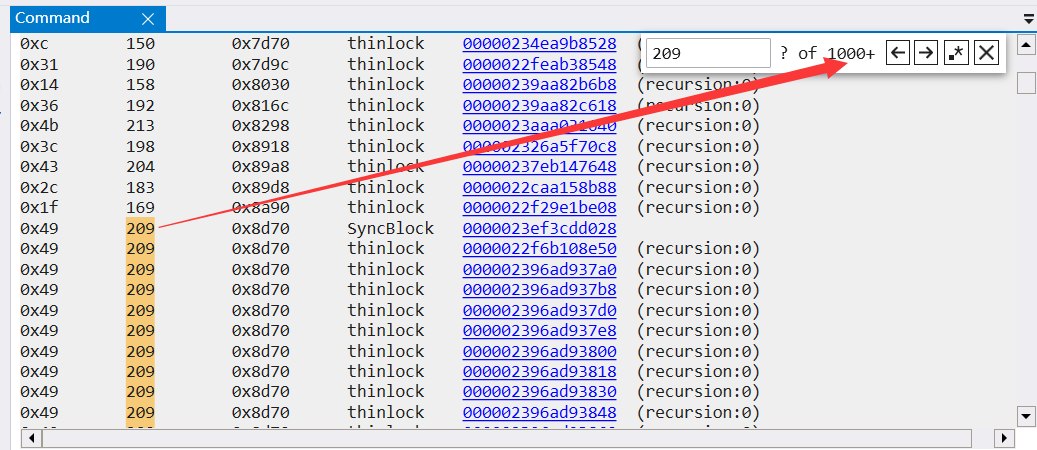
有些朋友可能不知道什麼叫 thinlock,簡單來說,它就是一種耗cpu的內旋鎖,類似 SpinLock,接下來隨便抽一個物件,檢視它的 !gcroot 。
0:000> !gcroot 000002396ad9ba48
Thread 2580:
000000d2fb0bef10 00007ff806945ab3 System.Threading.ExecutionContext.RunInternal(System.Threading.ExecutionContext, System.Threading.ContextCallback, System.Object, Boolean)
rbp-80: 000000d2fb0bef50
-> 0000023769dd4008 System.Threading.Thread
-> 0000023269e776b8 System.Runtime.Remoting.Contexts.Context
-> 0000023269e773b8 System.AppDomain
...
-> 0000023269ee1e00 System.Threading.TimerCallback
-> 0000023269ed2d30 System.Web.Caching.CacheExpires
-> 0000023269ed2c78 System.Web.Caching.CacheSingle
-> 0000023269ed2ce0 System.Collections.Hashtable
-> 000002372ab91d90 System.Collections.Hashtable+bucket[]
-> 00000239ab32fd10 System.Web.Caching.CacheEntry
-> 000002396ad93748 System.Collections.Concurrent.ConcurrentDictionary`2[[System.String, mscorlib],[xxx].Application.Entity.BaseManage.UserRelationEntity, xxx.Application.Entity]]
-> 00000239ab2a8248 System.Collections.Concurrent.ConcurrentDictionary`2+Tables[[System.String, mscorlib],[xxx.Application.Entity.BaseManage.UserRelationEntity, xxx.Application.Entity]]
-> 000002396ad96b80 System.Object[]
-> 000002396ad9ba48 System.Object
從輸出資訊看,這個 thinlock 來自於 ConcurrentDictionary 字典內部,接下來我們 dump 出這個字典,使用 !mdt 命令。
0:148> !mdt 000002396ad93748
000002396ad93748 (System.Collections.Concurrent.ConcurrentDictionary`2[[System.String, mscorlib],[xxx.Application.Entity.BaseManage.UserRelationEntity, xxx.Application.Entity]])
m_tables:00000239ab2a8248 (System.Collections.Concurrent.ConcurrentDictionary`2+Tables[[System.String, mscorlib],[xxx.Application.Entity.BaseManage.UserRelationEntity, xxx.Application.Entity]])
m_comparer:NULL (System.Collections.Generic.IEqualityComparer`1[[System.__Canon, mscorlib]])
m_growLockArray:true (System.Boolean)
m_keyRehashCount:0x0 (System.Int32)
m_budget:0x213 (System.Int32)
m_serializationArray:NULL (System.Collections.Generic.KeyValuePair`2[[System.__Canon, mscorlib],[System.__Canon, mscorlib]][])
m_serializationConcurrencyLevel:0x0 (System.Int32)
m_serializationCapacity:0x0 (System.Int32)
0:148> !mdt 00000239ab2a8248
00000239ab2a8248 (System.Collections.Concurrent.ConcurrentDictionary`2+Tables[[System.String, mscorlib],[xxx.Application.Entity.BaseManage.UserRelationEntity, xxx.Application.Entity]])
m_buckets:0000023e9a2477e8 (System.Collections.Concurrent.ConcurrentDictionary`2+Node[[System.String, mscorlib],[xxx.Application.Entity.BaseManage.UserRelationEntity, xxx.Application.Entity]][], Elements: 543997)
m_locks:000002396ad96b80 (System.Object[], Elements: 1024)
m_countPerLock:00000239aa8472c8 (System.Int32[], Elements: 1024)
m_comparer:0000023269e782b8 (System.Collections.Generic.GenericEqualityComparer`1[[System.String, mscorlib]])
從上面資訊看,這個字典有 54.3 w 條記錄,為啥這麼大,而且還有 1024 個 lock,有點意思,我們扒一下原始碼看看。
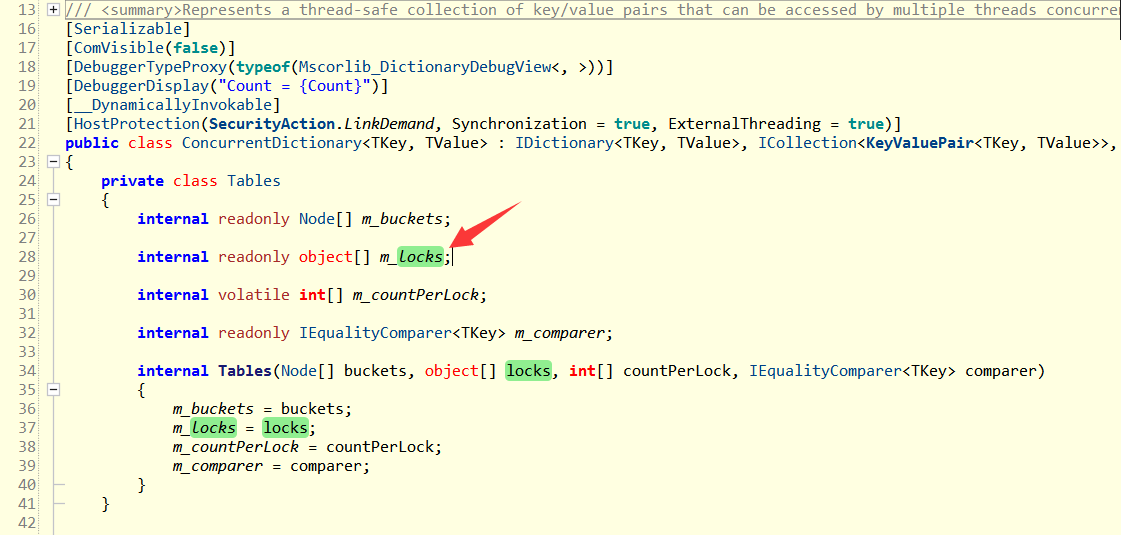
從原始碼看,內部確實有一個 lock[] 陣列,那到底是什麼操作引發了遍歷 locks[],要想尋找答案,可以在所有執行緒棧上尋找 ConcurrentDictionary 關鍵詞。
OS Thread Id: 0x2844 (163)
Child SP IP Call Site
000000d2fb83abb8 00007ff80a229df8 [GCFrame: 000000d2fb83abb8]
000000d2fb83aca0 00007ff80a229df8 [GCFrame: 000000d2fb83aca0]
000000d2fb83acd8 00007ff80a229df8 [HelperMethodFrame: 000000d2fb83acd8] System.Threading.Monitor.Enter(System.Object)
000000d2fb83add0 00007ff80693ea56 System.Collections.Concurrent.ConcurrentDictionary`2[[System.__Canon, mscorlib],[System.__Canon, mscorlib]].AcquireLocks(Int32, Int32, Int32 ByRef)
000000d2fb83ae20 00007ff806918ef2 System.Collections.Concurrent.ConcurrentDictionary`2[[System.__Canon, mscorlib],[System.__Canon, mscorlib]].AcquireAllLocks(Int32 ByRef)
000000d2fb83ae60 00007ff8069153f9 System.Collections.Concurrent.ConcurrentDictionary`2[[System.__Canon, mscorlib],[System.__Canon, mscorlib]].GetValues()
000000d2fb83aee0 00007ff7ae17d8ec xxx.Util.DataHelper.ToEnumerable[[System.__Canon, mscorlib],[System.__Canon, mscorlib]](System.Collections.Concurrent.ConcurrentDictionary`2<System.__Canon,System.__Canon>)
000000d2fb83af20 00007ff7ad125241 xxx.Application.Code.CacheHelper.GetCaches[[System.__Canon, mscorlib],[System.__Canon, mscorlib]](System.String)
000000d2fb83afa0 00007ff7ad12513b xxx.Application.Code.CacheHelper.GetCaches[[System.__Canon, mscorlib]](System.String)
000000d2fb83b000 00007ff7b10199e5 xxx.Application.Cache.CacheHelper.GetUserRelations()
從執行緒棧上看,發現了有近20處如上的程式碼,可以看出程式在呼叫 GetCaches 方法的時候觸發了 ConcurrentDictionary 的lock鎖從而卡住,接下來我們看一下 xxx.Application.Cache.CacheHelper.GetUserRelations() 原始碼到底做了什麼?
public static IEnumerable<UserRelationEntity> GetUserRelations()
{
return xxx.Application.Code.CacheHelper.GetCaches<UserRelationEntity>("xxx.BaseManage-UserRelation");
}
protected static IEnumerable<T> GetCaches<T>(string cacheKeyName)
{
return GetCaches<T, string>(cacheKeyName);
}
private static IEnumerable<T> GetCaches<T, TKey>(string cacheKeyName)
{
return GetConcurrentDictionaryCache<T, TKey>(cacheKeyName)?.ToEnumerable();
}
public static IEnumerable<T> ToEnumerable<TKey, T>(this ConcurrentDictionary<TKey, T> dics)
{
return dics.Values;
}
從原始碼邏輯看,程式每次呼叫快取最終都會呼叫 dics.Values , 我很好奇它的框架邏輯是什麼樣的? 截圖如下:
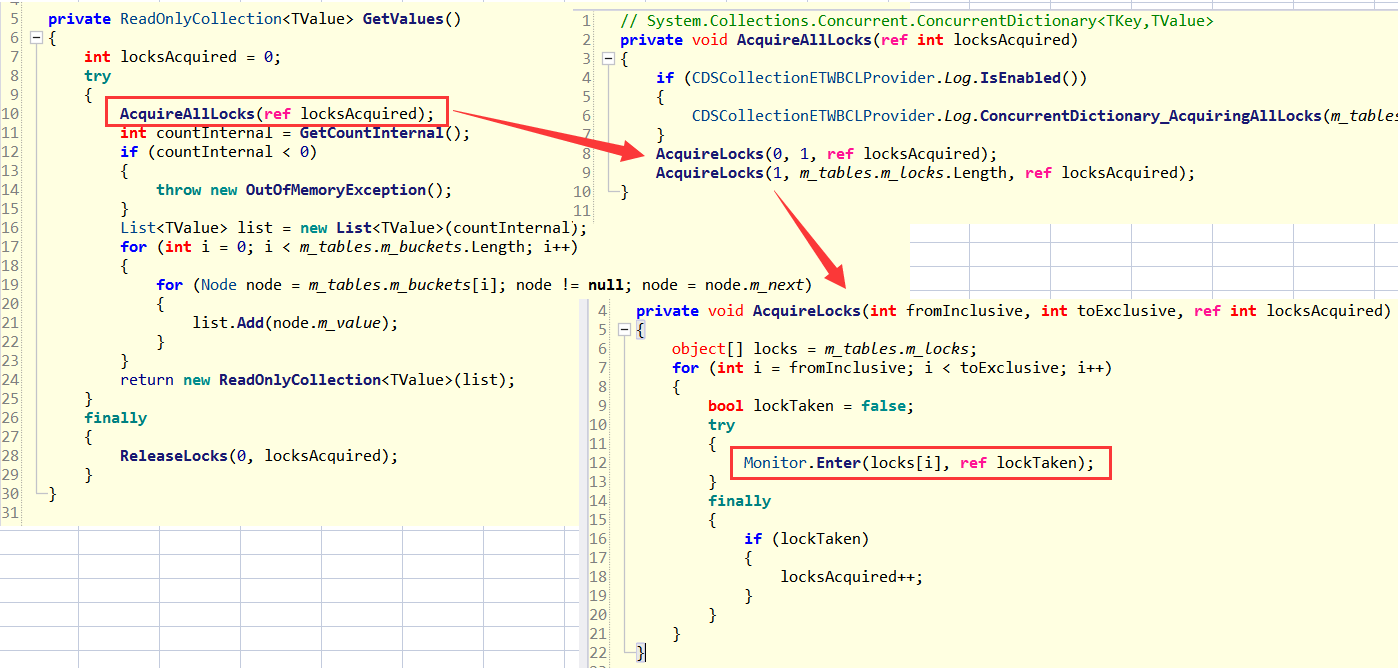
大家有沒有發現,每次 dict.Values 時都要執行 1024 次 Monitor.Enter(locks[i], ref lockTaken);, 也就是 1024 次的內旋鎖,這就是cpu高的一個關鍵因素。
3. 記憶體爆高原因
最後一個問題是記憶體為啥會爆高? 細心的朋友應該會發現剛才那個 GetValues 中有一個奇怪的邏輯 ,我再貼一下程式碼:
private ReadOnlyCollection<TValue> GetValues()
{
int locksAcquired = 0;
try
{
AcquireAllLocks(ref locksAcquired);
int countInternal = GetCountInternal();
if (countInternal < 0)
{
throw new OutOfMemoryException();
}
List<TValue> list = new List<TValue>(countInternal);
for (int i = 0; i < m_tables.m_buckets.Length; i++)
{
for (Node node = m_tables.m_buckets[i]; node != null; node = node.m_next)
{
list.Add(node.m_value);
}
}
return new ReadOnlyCollection<TValue>(list);
}
finally
{
ReleaseLocks(0, locksAcquired);
}
}
有沒有發現,每一次 GetValues 時都會生成一個 54.3w 大小的新List,請注意這個 list 是新生成的,不是 ConcurrentDictionary 上的引用,這就很坑了,每呼叫一次,LOH上就會來一個這麼大的List,你說記憶體暴增不暴增???
三:總結
總的來說,這苦逼的三高有下面兩個因素造成。
- 使用了同步的 HttpRequest 方式並使用了外網url導致程式掛死。
優化措施:使用非同步方式
- 巨坑的 ConcurrentDictionary.Values 導致 記憶體,cpu 爆高。
我想很多朋友都沒想到: ConcurrentDictionary.Values 有這麼大的一個坑,這就讓我聯想起了執行緒不安全的 Dictionary.Values 是怎麼做的?
public ValueCollection Values
{
[__DynamicallyInvokable]
get
{
if (values == null)
{
values = new ValueCollection(this);
}
return values;
}
}
public sealed class ValueCollection
{
public ValueCollection(Dictionary<TKey, TValue> dictionary)
{
if (dictionary == null)
{
ThrowHelper.ThrowArgumentNullException(ExceptionArgument.dictionary);
}
this.dictionary = dictionary;
}
}
可以很明顯的看到它並沒有生成新的list,所以優化措施如下:
- 拒絕使用 ConcurrentDictionary.Values,採用
lock + Dictionary。 - 如果硬要用 ConcurrentDictionary ,請將 Query 條件送下去,而不是使用 Values 做全量拉取再查詢,減少記憶體無畏佔用。
最後上一個小彩蛋,將分析結果給了這位朋友之後,朋友想讓我上門分析,第一次遇到。。。太猝不及防啦

